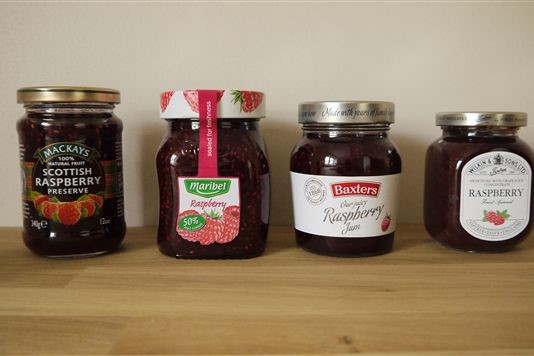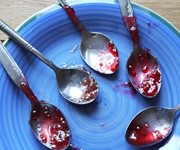Basic Britain: raspberry jam

Spread on toast or spooned into a tart, a good jam can make all the difference. But does a quality preserve mean spending more? Laura Rowe takes a look at the big brands against the budget.
Making homemade jam has got to be one of the most basic joys of late summer and autumn. But how does the jam making process differ on a commercial scale? And does spending more mean better value for money? I took a look at four different raspberry jams:
• Tiptree Raspberry Fruit Spread £1.99/285g (available from Redmoped.co.uk, independent food shops, farms and delis).
• Mackays Scottish Raspberry Preserve £1.49/340g (available from major supermarkets)
• Baxters Raspberry Jam £1.58/340g (available from major supermarkets)
• Maribel Raspberry Conserve Extra Jam 85p/450g (available from Lidl)
What’s in a typical jar?
 While at home jam making might be kept as simple as the combination of fruit and sugar, commercial jam making is seemingly a lot more secretive. Essex-based brand Tiptree told us that it gets its raspberries from a variety of sources. The majority of its fruit is grown at Tiptree, some are bought locally and many are also sourced from Scotland. But it couldn’t tell us the variety of berries used. The fruit (55% raspberries) is cooked from frozen, sweetened with grape juice concentrate, then lemon juice and pectin are added to make the fruit spread set.
While at home jam making might be kept as simple as the combination of fruit and sugar, commercial jam making is seemingly a lot more secretive. Essex-based brand Tiptree told us that it gets its raspberries from a variety of sources. The majority of its fruit is grown at Tiptree, some are bought locally and many are also sourced from Scotland. But it couldn’t tell us the variety of berries used. The fruit (55% raspberries) is cooked from frozen, sweetened with grape juice concentrate, then lemon juice and pectin are added to make the fruit spread set.
Baxters failed to give us any information about its jam. On the website it says that only the “finest fruits” are used in a “classic recipe”. Look on the label of the jar and it reveals that it’s made from 50% raspberries, along with sugar, lemon juice, citric acid, pectin and concentrated lime juice.
Mackays uses “raspberries grown in the berry fields of eastern Scotland”; specifically, it tells us, Glen Ample raspberries. Its team said “Glen Ample produces large, fleshy fruits of about 4-5g which are round, conical in shape, attractive and with an excellent flavour. Cropping starts early July and carries through to mid August”. The fruits are then frozen after picking and defrosted prior to cooking, although “in the summer months we go from field to jar”. The preserves are then made in large, open copper jam pans, where the fruit and sugar is slowly boiled up and produced in small batches. Because the natural levels of pectin varies in the fruit, extra pectin is added to ensure consistency in the product, while citric acid is added dependent on the natural pH of the jam. To ensure the pectin is activated the pH has to be controlled between 2.9 and 3.2.
Maribel, our budget range from Lidl, uses frozen raspberries from Europe to make its jam. A range of varieties are used according to the season, and sugar, glucose-fructose syrup, pectin and citric acid are all added to the pot.
Maribel and Baxters use 50g of fruit per 100g sugar, Mackays uses 35g of fruit per 100g, while Tiptree uses 55% fruit with the grape juice concentrate.
How do they taste?
In our taste test, Mackays came out on top. Our judging panel liked the balance of sweet and sour, the authentic taste of raspberries and the fact it didn’t have too many pips. The thick consistency meant it spread well. Baxters had a good vibrant pink colour, great flavour and a pleasant sharpness. It had a few too many pips for us though. Tiptree didn’t look or taste like a traditional raspberry jam – it was more dark rusty red than pink, and it was very sweet. Maribel tasted of pure raspberries and had a good consistency but again had an intense sweetness.
So, does spending £1 or £2 make a difference? Well, it depends how sweet you like your jam. But the budget jar is definitely worth giving a go. It contains the same ingredients as the brands and has a good flavour.
Would you go budget on jam? Let us know in the comments box below.
You might also like
Comments
Be the first to comment
Do you want to comment on this article? You need to be signed in for this feature